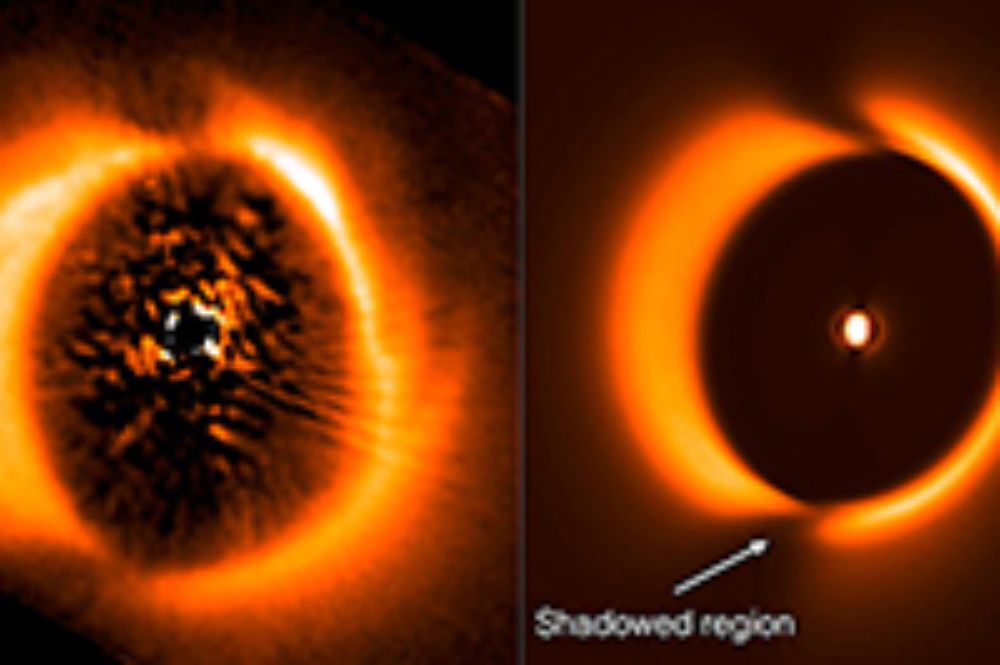A piece in the puzzle of how planets form has been unlocked thanks to new insight on planet forming systems. Planets are thought to form in disks of gas and dust that surround new born stars. Assuming that these protoplanetary disks lie in a single plane, all proto-planets tend to be contained in that plane too, much like the planets in our Solar System revolve in coplanar orbits. Interestingly, astronomers at the University of Chile have recognized the existence of shadows in a planet forming system, which require at least two tilted disks.
Right next to our Solar neighbourhood lies HD142527, a young star surrounded by a large disk rich in gas and dust. This is one of the best studied protoplanetary systems because of its large size, its proximity to us and the variety of ‘planet formation sign posts’ that hint to the presence of newborn planets. As giant planets grow they carve wide trails in the disk along its orbit, leaving rings with less gas and dust that astronomers call gaps. HD142527 exhibits the largest such gap known so far – one could fit three times Neptune’s orbit inside. This gap divides the disk in two distinctive zones: an outer disk (which contains most of the mass) and an inner disk. By comparing different three-dimensional models of the disk with empirical data, astronomers at the Millennium ALMA Disk Nucleus, a.k.a MAD, identified and constrained the geometry of the system. The study was first authored by young scientist Mr. Sebastian Marino, a starting M.Sc. student at U. de Chile.
Images of the HD142527 disk taken with state-of-the-art instrumentation on large 8 meter-class telescopes, showed two peculiar dark regions, far away from the central star (see above image). These dark regions defied interpretations since they were first seen, in 2011. The new study, published in the Astrophysical Journal Letters, reveals that the inner disk in HD142527 is inclined with respect to the outer disk by about 70 degrees, blocking the star’s light and casting shadows across the gap. The projected shadows coincide with the observed dark regions. The phenomenon is similar to a solar eclipse, in which the Moon blocks the sunlight casting a shadow over Earth, but in this case it is the inner part of the disk what blocks the central star’s light.
Most protoplanetary disks last for only a few million terrestrial years, which is very short compared to the age of planetary systems, making a young disk rich in gas a rather scarce finding. It is during the first few millions of years that giant planets are formed, racing against the quick dispersal and evaporation of the primordial protoplanetary material. The inner disk of HD142527 is about the size of Saturn’s orbit, which means that understanding its evolution could be key to how Earth-like planets form. At the same time, it is very difficult to study these regions since their small sizes on the sky—a millionth of the size of the Moon— and their proximity to the star forbid detailed study with current telescope capabilities. The phenomenon discovered by Marino et al. allows the study of such unreachable regions of planet forming systems, thanks to the shadows cast on larger scales.
The inclined inner disk in HD142527 was inferred using detail 3D modeling of how the star’s light propagates from the central region through the surrounding material, using a technique called “radiative transfer” (see video aside). But, how does nature produce this configuration? One of the possible explanations requires a companion object, say a planet or a small star, hidden inside the disk. Interestingly, previous studies show evidence for such object. “The astounding fact is that this planet would most likely need to be in a highly inclined orbit, just like the inner parts of the disk. Which poses more interesting questions about the dynamical stability of such arrangement” –says Dr Sebastian Perez, co-author of the research letter.
Warped inner parts of disks have been seen in a variety of astronomical objects, from galaxies to material surrounding black holes. The particular case of HD142527’s shadows may be extended to other protoplanetary disks. “This shadowing may have strong consequences on the physical conditions that lead to planet formation since these regions will be colder and denser than their surroundings, which changes the properties of the primordial gas and dust” –says Dr. Simon Casassus, MAD Principal Investigator.
Although the origin of these warped inner disks is still to be determined, “we now know how to better interpret observations of protoplanetary disks, and what features to look for in other nearby planet forming stars” –says Mr. Sebastián Marino. Protoplanetary disks, which we thought of as peaceful places where planets form, can in fact harbor dramatic dynamics.


